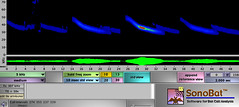Backyard bats
Studying bats is a challenge, because we can't really see them, and we can't hear them. So I need technological assistance - this is where that previous career in software development comes in handy. To hear them, I use a device that records sound higher than we can hear, that is, ultrasound. The calls automatically trigger the detector, and they are recorded onto a simple MP3 player and later uploaded to my computer for analysis.
This is a sonogram, or computer analysis, of calls that I recorded last night in a friend's back yard. I'm frankly not sure what kind of bat it was, or perhaps it was multiple bats. Most likely it's a freetail, but the signature frequency seems a bit high. I'm still a beginner at the analysis part.
The bats that visited my friend's back yard were looking for dinner. It was quite cold and windy, so it's hard to believe that many bugs were out, but bat's can't exactly just stop off at the grocery store or order take-out. The calls recorded here were not social calls, but rather calls designed to bounce off any tasty bugs flying around, so that the bat could chase them, and catch them, and eat them. Yum!
I recorded this using a Pettersson ultrasound recorder D240X. The visual you see is a screen capture from Sonobat software's analysis of the call. You can see the frequency of the calls along the Y axis (on the left) and time is on the X axis, along the bottom. The bat, or bats, flew along above the recorder calling out multiple times. The calls tended to start at about 50 kHz and descend to about 30, with the most power happening at about 35 kHz. Each call lasted about 8 milliseconds. Just for reference, humans can hear up to about 20 kHz, so these bats are not audible to us without some kind of detector like this.


